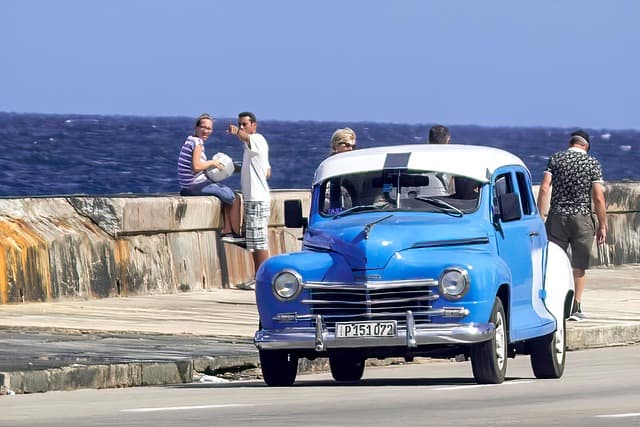Cuba is a country with a unique culture and history, and the transportation system on the island is no exception. It has its own peculiarities and nuances, which should be taken into account when planning a trip. You’ll find a variety of ways to get around, from ancient cabs to modern bus routes and trains, each of which will give you a chance to see Cuba from a different perspective.
Cabs in Cuba
Cabs in Cuba are one of the most popular and convenient ways to get around. There are several types of cabs that vary in comfort and cost.
Fixed-fare cabs (tourist cabs):
- These cabs are usually offered through travel agencies or hotels and are often used for transfers between cities or for sightseeing trips.
- They can be either modern cars or classic cars such as vintage American cars from the 50s, which are one of Cuba’s trademarks.
- The cost of a ride in these cabs is negotiated in advance, and can usually be a little higher than in regular cabs.
Cabs by meter (pei-system cabs):
- In larger cities, such as Havana, there are cabs that use meters. These cabs can be more affordable, but it’s important to make sure the cab driver turns on the meter when you get into the car.
- Some cab drivers in Cuba may haggle, especially if you don’t use an official taximeter.
Retro cars (American cars from the 50s):
These cars are not only popular among tourists, but are also an integral part of Cuban culture. In Havana and other major cities, you can find retro cabs that offer a unique experience of traveling around the city in vintage cars. The cost of these rides is usually higher than regular cabs, but they offer tourists a nostalgic atmosphere.
Shared Taxis:
Also common in Cuba are so-called “shared cabs” (cars that pick up several passengers along the way), which are often used for traveling between cities. These cabs are usually more economical, as passengers share the cost of the trip.
Buses in Cuba
Cuba’s bus system is a more accessible and less expensive way to get around the country. It provides a variety of options for tourists and locals.
Viazul Buses:
- This is the most popular tourist bus transportation network in Cuba. Viazul connects major tourist cities like Havana, Varadero, Trinidad and others. Viazul buses are comfortable, with air conditioning and simple amenities, and their schedules are usually accurate.
- Tickets can be purchased online or at Viazul offices in major cities. Although Viazul provides good value for money, seats on popular routes may sell out in advance, especially during the high tourist season.
National Buses (ASTRO):
- This is a public bus transportation network that serves locals and tourists. ASTRO buses are more basic and often less comfortable than Viazul, but they can be a convenient option for those looking to save money. -ASTRO also connects Cuba’s main cities, but on-board amenities can be limited and buses can be crowded during peak season.
Local buses:
Major cities like Havana and Santiago de Cuba also have a network of local buses that serve residents and tourists. This is a cheap way to get around, but the buses can be crowded and are not always air-conditioned.
Trains in Cuba
Trains in Cuba are a less popular way to travel, but still an interesting option for those who want to see the country from a different perspective.
Trains via Ferrocarriles de Cuba:
- Cuba’s trains are operated by Ferrocarriles de Cuba, the national railroad company. They connect big cities such as Havana, Varadero, Cienfuegos and others. The trains are usually not as modern as in other countries, and they may not be very comfortable, but they are a budget-friendly way to travel.
- There are standard trains as well as more comfortable (paid) cars, with air conditioning and better amenities. However, it’s worth bearing in mind that train service in Cuba is not always accurate, and trains can be late.
Trains for tourists:
- Special trains are available for tourists, such as the Tourist Train in Cuba (such as the Tropicana Train), which provides a unique experience traveling around the island. These trains are usually air-conditioned and offer a comfortable journey, but they are much more expensive than regular trains.
Tips for transportation in Cuba:
- Prepare in advance: Transportation in Cuba may not be as fast or convenient as in other countries, so it’s best to plan your travel time in advance.
- Keep an eye on schedules: This is especially important for buses and trains – due to various technical and logistical issues, delays can be frequent.
- Use local drivers: For short trips around the city, cab drivers often offer reasonable rates, but be prepared for possible price negotiations.
- Buy tickets in advance: If you plan to travel between cities, it’s best to buy tickets in advance, especially for Viazul buses, to avoid problems with unavailability of seats.
Conclusion
Transportation in Cuba is diverse and despite some limitations and peculiarities, it is quite affordable for tourists. Whether by cab, bus or train, each mode of transportation allows you to see the island from a different perspective and immerse yourself in the Cuban atmosphere.



